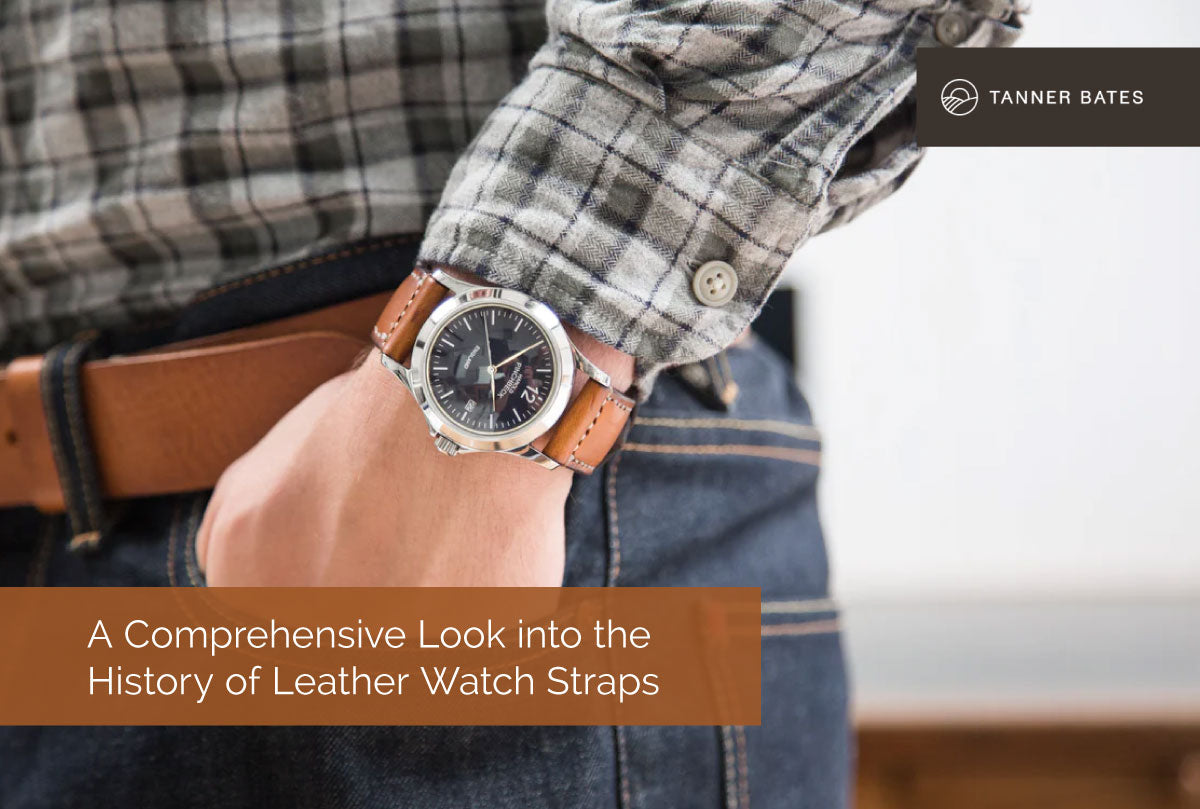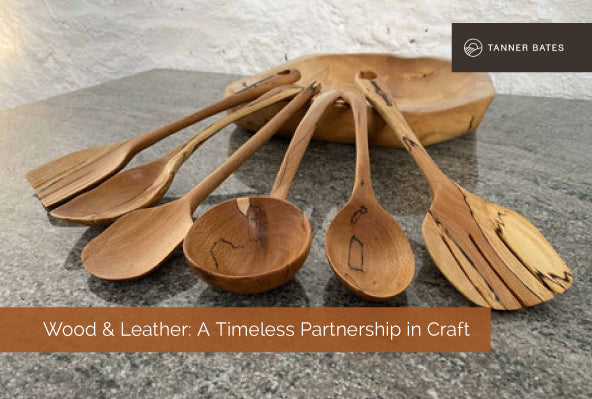August 30, 2023
A Comprehensive Look into the History of Leather Watch Straps
Throughout the centuries, watches have undergone numerous transformations, evolving from simple timekeeping devices into fashionable accessories. One of the most significant advancements in watch design was the introduction of leather watch straps. This article delves into the intriguing history of leather watch straps, from their humble beginnings to their current status as sought-after fashion essentials.
The Genesis of Watch Straps
Before the invention of wristwatches, timepieces were primarily pocket watches, which didn't require straps. The earliest timekeepers were attached to clothing with chains, providing a secure and convenient means of carrying the watch. However, as time progressed and watch design evolved, there arose a need for a more practical solution to keep the watches in place, thereby leading to the development of the first watch straps.
The Indispensable Influence of War
The genesis of leather watch bands can be traced back to the
Boer War in South Africa. As the region's climate was sweltering, soldiers had to innovate new ways to carry their watches. The intense heat made it uncomfortable to keep their pocket watches in their jackets, prompting them to attach their timepieces to primitive leather bands, thus creating the initial versions of wristwatches.
The Advent of Leather Watch Straps
Historically, leather watch straps were initially used during the late nineteenth century amidst wars such as the Freedom Wars in South Africa and the Third Burma War of 1885. The necessity for a hassle-free way to access time, especially during critical military operations, led to the creation of leather watch straps. These straps, initially simple and rudimentary, evolved over time, becoming more complex and appealing.
The Emergence of Metal Straps
Parallel to the development of leather straps was the rise of metal straps. The first wristwatches, predominantly worn by women, were adorned with bracelets. As the nineteenth century drew to a close, the influence of various wars brought about a shift in fashion, leading to the popularity of metal straps. These straps, alongside the newly introduced leather straps, transformed the watch industry, offering users a wider array of choices.

The Twentieth Century: A Time of Innovation
During the twentieth century, there were significant changes in the design and functionality of watch straps. Companies like
Rolex started using leather straps, further popularising them. The necessity of the Boer War soldiers, who innovatively transformed their pocket watches into wristwatches, inspired
Wilsdorf and Davis, the founders of Rolex.
Leather in the Modern Era
The modern era has seen an explosion in the variety of materials used for watch bands, from metal bracelets and rubber bands to the
timeless leather watch band. The luxury and durability of leather have made it a favoured choice for watch enthusiasts, with various styles and designs available to cater to individual preferences.

The Future of Leather Watch Straps
The future of leather watch straps is promising, with continuous advancements in design and craftsmanship. As fashion trends evolve, so too does the demand for innovative and stylish watch straps. Regardless of the introduction of alternative materials, the timeless appeal of leather ensures its enduring popularity in the world of watchmaking.
In conclusion, the history of
leather watch straps is as rich and diverse as the material itself. From its humble beginnings during wartime to its current status as a luxury accessory, leather watch straps have continuously evolved, adapting to changing trends and user needs. As we look forward to the future, one thing is certain - the appeal of leather watch straps is timeless, offering a perfect blend of style, comfort, and durability.
Frequently asked questions about Leather Watch Straps.
Are leather watch straps worth it?
Leather watch straps can be a great option for many watch enthusiasts, offering several benefits, but they also have some drawbacks. Here's a breakdown of the pros and cons of leather watch straps to help you decide if they are worth it for you:
Pros of Leather Watch Straps:
1. Aesthetics: Leather watch straps are often considered more elegant and sophisticated than other types of straps. They are available in various colours, textures, and styles, allowing you to customise your watch's look.
2. Comfort: Leather straps can be very comfortable, as they are soft, flexible, and can conform to the shape of your wrist over time.
3.
Durability: High-quality
leather watch straps can last for many years if properly cared for. They can develop a unique patina over time, adding to their character.
4. Versatility: Leather straps can be dressed up or down, making them suitable for both formal and casual occasions.
Cons of Leather Watch Straps:
1. Maintenance: Leather straps require regular maintenance to prevent them from drying out, cracking, or staining. You should avoid exposing them to water, sweat, or chemicals and clean them periodically with a leather conditioner such as our Tanner Bates Hide Food.
2. Durability Concerns: Leather straps are generally not as durable as metal or synthetic straps, particularly in harsh conditions or when exposed to moisture. But if looked after, they can last a lifetime.
3. Cost: High-quality leather watch straps can be more expensive than other types of straps, especially if they are made from exotic leather.
Ultimately, whether a leather watch strap is worth it completely depends on your preferences, budget and lifestyle. If you appreciate the aesthetics and comfort of leather and are willing to care for it properly, a leather watch strap can be a great investment. However, if you are looking for a more durable and low-maintenance option, you may want to consider a metal or synthetic watch strap.
Why are leather strap watches better?
Leather strap watches offer several advantages over other types of watch straps. Here are some reasons why leather strap watches might be considered better:
1. Style and Elegance: Leather watch straps have a timeless, classic appearance that exudes sophistication. They are versatile enough to be worn in casual or formal settings and be easily matched with different outfits.
2. Comfort: Leather is a natural material that is soft and breathable. As you wear a leather strap, it moulds to the shape of your wrist, making it one of the most comfortable watch strap materials.
3. Customisation: Leather straps come in various colours, textures, and finishes, allowing you to personalise your watch to suit your style. From smooth to textured, matte to glossy, and understated to exotic, there's a leather strap for every taste.
4. A Unique Patina: Over time, a high-quality leather strap will develop a patina, a natural ageing process that enhances the leather's appearance. This patina gives the strap character and makes your watch truly unique.
5. Lightweight: Leather straps are typically lighter than metal bracelets, making them more comfortable for long-term wear.
6. Hypoallergenic: Genuine leather straps are less likely to cause skin irritation compared to some metal bracelets, especially for those with sensitive skin or metal allergies.
7. Easy to Change: Leather straps are generally easier to change than metal bracelets, allowing you to switch up your watch's look without professional help.
8. Quieter: Leather straps don't make a noise like metal bracelets, which can be a plus in quiet settings.
However, it's essential to consider that leather straps might not be the best choice for everyone. They require more maintenance than metal or synthetic straps, are less water-resistant, and may not be as durable in certain conditions. Additionally, some people may have ethical or environmental concerns about using animal products.
In conclusion, leather strap watches are considered better for their style, comfort, and customisation options, but they may not be the best choice for everyone or every situation. It ultimately depends on your personal preferences, needs, and values.
Does water ruin the leather watch strap?
Yes, water can damage leather watch straps. Leather is a natural material, and prolonged exposure to water can cause it to lose its natural oils, leading to drying, cracking, and stiffness. Additionally, water can cause the leather to stain, discolour, or warp.
Here are some tips for protecting your leather watch strap from water damage:
1. Avoid Immersion: Try not to immerse your leather watch strap in water. If your watch is water-resistant, remember that the strap may not share the same resistance level.
2. Wipe-Off Splashes: If your leather strap gets wet, gently blot it with a soft, dry cloth to remove excess moisture. Do not rub the leather, as this can push the water further into the material.
3. Air Dry: If your strap gets wet, let it air dry at room temperature. Avoid using heat sources like hairdryers, as they can cause the leather to dry out and crack.
4. Condition the Leather: Use a leather conditioner or cream periodically to maintain the strap's suppleness and prevent it from drying out. This is especially important if the strap has been exposed to water.
5. Avoid Humid Environments: If you live in a humid area or plan to engage in activities that may expose your watch to moisture (e.g., exercising or washing dishes), consider switching to a more water-resistant strap material like silicone, rubber, or metal.
Remember that while some leather watch straps may be treated to be more water-resistant, no leather strap is entirely waterproof. Taking proper care of your leather watch strap can help prolong its life and maintain its appearance.
Can you wear a leather strap watch every day?
Yes, you can wear a leather strap watch every day, but there are some considerations to keep in mind to ensure the longevity and appearance of the strap:
1. Rotate Your Watches: If you have multiple watches, consider rotating them to give each leather strap some rest. This allows any accumulated moisture to evaporate and prevents excessive wear on one strap.
2. Avoid Water and Humidity: As mentioned earlier, water can damage leather straps. If you're going to be around water or in a humid environment, you might want to switch to a watch with a different type of strap.
3. Sweat Considerations: Leather can absorb sweat, which can lead to odours and premature wear. If you're going to engage in physical activity, consider wearing a watch with a strap made from a more sweat-resistant material like silicone or rubber.
4. Cleaning and Conditioning: Clean and condition your leather strap regularly, with a natural leather conditioner to keep it supple and prevent cracking.
5. Storage: When you're not wearing your watch, store it in a cool, dry place, away from direct sunlight or heat sources, which can cause the leather to dry out and fade.
By taking proper care of your leather watch strap, you can enjoy wearing it every day while maintaining its appearance and longevity.
Should watch straps be thick or thin?
The choice between a thick or thin watch strap depends on various factors, such as your wrist size, the watch case size, your personal style, and the occasions on which you plan to wear the watch. Here are some considerations to help you decide:
1. Wrist Size: Generally, people with larger wrists may prefer thicker straps, while those with smaller wrists might opt for thinner straps. The strap should be proportional to your wrist size for a balanced look.
2. Watch Case Size: The strap should also be proportional to the watch case size. A large watch case might look better with a thicker strap, while a small watch case might be better suited for a thin strap.
3. Style Preference: Your personal style plays a significant role in the choice of strap thickness. If you prefer a bold, rugged look, a thicker strap might be more suitable. On the other hand, if you lean towards a sleek, minimalist style, a thin strap might be a better choice.
4. Occasion: Thicker straps tend to have a more casual, sporty appearance, while thinner straps are often seen as more elegant and formal. Consider the occasions and settings in which you plan to wear the watch.
5. Comfort: The thickness of the strap can also affect comfort. Some people may find thick straps more comfortable and secure, while others may prefer the lightness of thin straps.
6. Trend: Fashion trends can also influence your choice. However, it's essential to prioritise your comfort and personal style over temporary trends.
Remember, there's no one-size-fits-all answer when it comes to watch strap thickness. It's essential to consider your preferences, the watch's design, and the context in which you'll wear it to find the strap that suits you best.
Should I get a brown or black leather watch strap?
The choice between a brown or black leather watch largely depends on your personal style and the occasions or outfits you plan to pair the watch with. Both colours have their advantages and can be versatile additions to your wardrobe. Here are some considerations to help you decide:
Black Leather Watch:
1. Versatility: Black is a neutral colour that pairs well with most outfits, making it a versatile choice for both casual and formal settings.
2. Formality: Black leather watches are often seen as more formal and professional than brown ones. They are an excellent choice for business attire, formal events, or evening wear.
3. Monochrome Outfits: If you often wear monochrome or all-black outfits, a black leather watch can complement your look seamlessly.
Brown Leather Watch:
1. Warmth: Brown leather has a warmer, more natural appearance than black leather, making it a great option for casual and relaxed settings.
2. Earth Tones: Brown leather watches pair exceptionally well with earth-toned outfits, including beige, tan, olive, and navy.
3. Variety: Brown leather comes in various shades, from light tan to dark chocolate, allowing you to choose a hue that suits your style and complements your skin tone.
4. Casual Elegance: Brown leather watches strike a balance between casual and elegant, making them suitable for both everyday wear and semi-formal occasions.
Ultimately, your decision should be based on your personal style, wardrobe, and the context in which you plan to wear the watch. If you can, consider having both a black and a brown leather watch in your collection to cover a wide range of occasions and outfits.
Can you put a leather band on any watch?
You can generally put a leather band on any watch, provided that the band is the right size and style for the watch case. However, there are a few factors to consider when choosing a leather band for your watch:
1. Lug Width: The lug width, also known as the bandwidth, is the distance between the two lugs (projections) on the watch case where the strap attaches. Measure the lug width of your watch case and choose a leather band of the same width.
2. Watch Style: While you can technically put a leather band on any watch, the style of the watch case should match the style of the band. For example, a leather strap with stitching may look great on a classic or vintage-style watch but may not be as suitable for a modern or sporty watch.
3. Band Thickness: Consider the thickness of the leather band in relation to the watch case. A thick leather band might overpower a small, delicate watch case, while a thin leather band may look out of place on a large, rugged watch case.
4. Attachment Mechanism: Ensure that the attachment mechanism of the leather band is compatible with your watch case. Most watches use spring bars or quick-release pins for strap attachment. Check that the leather band you're considering has the appropriate attachment mechanism.
5. Colour and Finish: Consider the colour and finish of the leather band in relation to the watch case. A black or brown leather band is a classic choice that complements most watch cases, but you can also choose from various colours, textures, and finishes to match your personal style.
6. Watch Usage: If you plan to use your watch in water or during physical activities, a leather band may not be the best choice. Leather can be damaged by water, sweat, and abrasion. Consider the intended use of your watch when deciding on a leather band.
Ultimately, choosing a leather band for your watch is a matter of personal preference and matching the band's style, size, and attachment mechanism with your watch case. With the right leather band, you can enhance the look of your watch and add a touch of elegance and sophistication to your timepiece.
Leave a comment
Comments will be approved before showing up.






